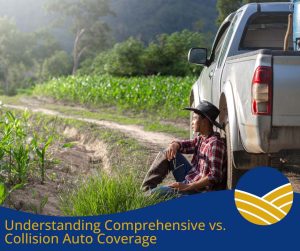Understanding Comprehensive vs. Collision Auto Coverage
When it comes to auto insurance, navigating the various types of coverage can be daunting. Two essential components of an auto insurance policy are comprehensive and collision coverage. Understanding the differences between these two types of coverage is crucial for drivers looking to protect their vehicles from a variety of risks.
Comprehensive Coverage: Comprehensive coverage, often referred to as “comp,” provides protection for your vehicle against damages that occur outside of accidents involving other vehicles. It typically covers damages caused by:
● Theft
● Vandalism
● Fire
● Natural disasters (e.g., hurricanes, floods, earthquakes)
● Falling objects (e.g., tree branches)
● Animal collisions
Comprehensive coverage is optional but may be required if you have a car loan or lease. It helps pay for repairs or replacement of your vehicle if it’s damaged or stolen due to covered incidents, minus your deductible. Comprehensive coverage is valuable for drivers who want comprehensive protection against a wide range of non-collision risks.
Collision Coverage: Collision coverage, as the name suggests, covers damages to your vehicle resulting from collisions with other vehicles or objects, regardless of fault. It includes damages caused by:
● Accidents with other vehicles
● Collisions with stationary objects (e.g., guardrails, poles, fences)
● Rollovers
Collision coverage is also optional but may be required by lenders if you finance or lease your vehicle. Like comprehensive coverage, collision coverage helps pay for repairs or replacement of your vehicle, minus your deductible. Collision coverage is essential for drivers who want financial protection against damage sustained in accidents.
Key Differences
– Covered Perils: Comprehensive coverage protects against non-collision incidents, such as theft, vandalism, and natural disasters, while collision coverage protects against damages resulting from collisions with other vehicles or objects.
– Fault Consideration: Comprehensive coverage pays for damages regardless of fault, whereas collision coverage applies to accidents where you collide with another vehicle or object.
– Types of Damage: Comprehensive coverage extends to a broader range of damages, including those caused by non-human factors like theft and weather events, whereas collision coverage focuses specifically on damages resulting from collisions.
– Optional vs. Required: While both comprehensive and collision coverage are optional, lenders may require collision coverage for financed or leased vehicles, but not necessarily comprehensive coverage.
Deciding between comprehensive and collision coverage depends on factors such as your driving habits, geographic location, vehicle value, and financial situation. Some drivers opt for both types of coverage for maximum protection, while others may choose one or the other based on their individual needs and budget.
Comprehensive and collision coverage are essential components of auto insurance policies, offering protection against a wide range of risks and hazards on the road. By understanding the differences between these two types of coverage and assessing your specific needs, you can make informed decisions about the level of protection that’s right for you and your vehicle. Remember to review your coverage regularly and adjust it as needed to ensure you have adequate protection for your driving needs. With the right coverage in place, you can drive with confidence, knowing that you’re prepared for whatever comes your way on the road.
With more than 55 agents and 60 locations across the state of Montana, Farmers Union Insurance is equipped to guide you in important insurance decisions to protect what matters most to you. To find your local agent, click here.
Disclaimer: The content provided in this blog is for informational purposes and should not be considered an offer for coverage. Each insurance policy is unique and may have varying terms, conditions, and exclusions. It is essential to consult with a qualified insurance professional or licensed agent for personalized advice tailored to your specific needs. This blog does not constitute a contract, policy, or guarantee of coverage. Always refer to your individual policy documents for full details.
